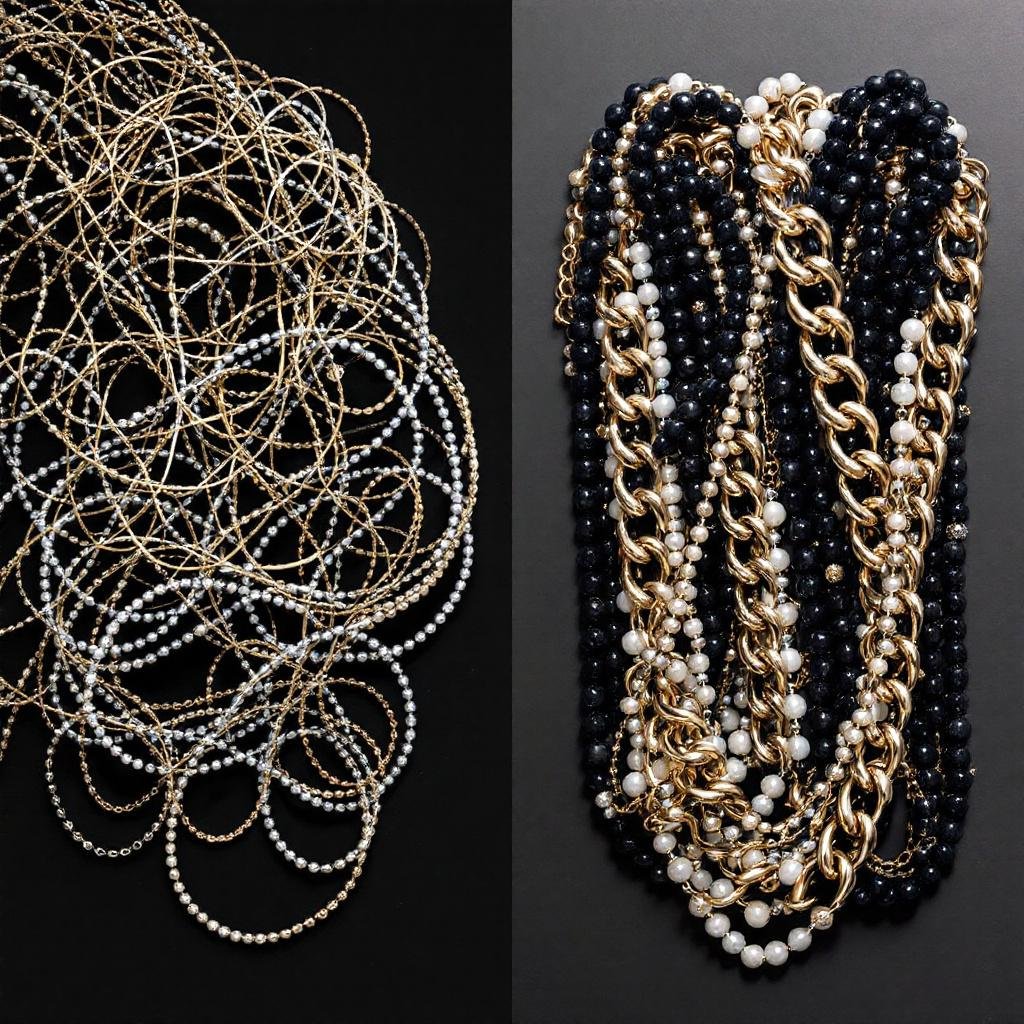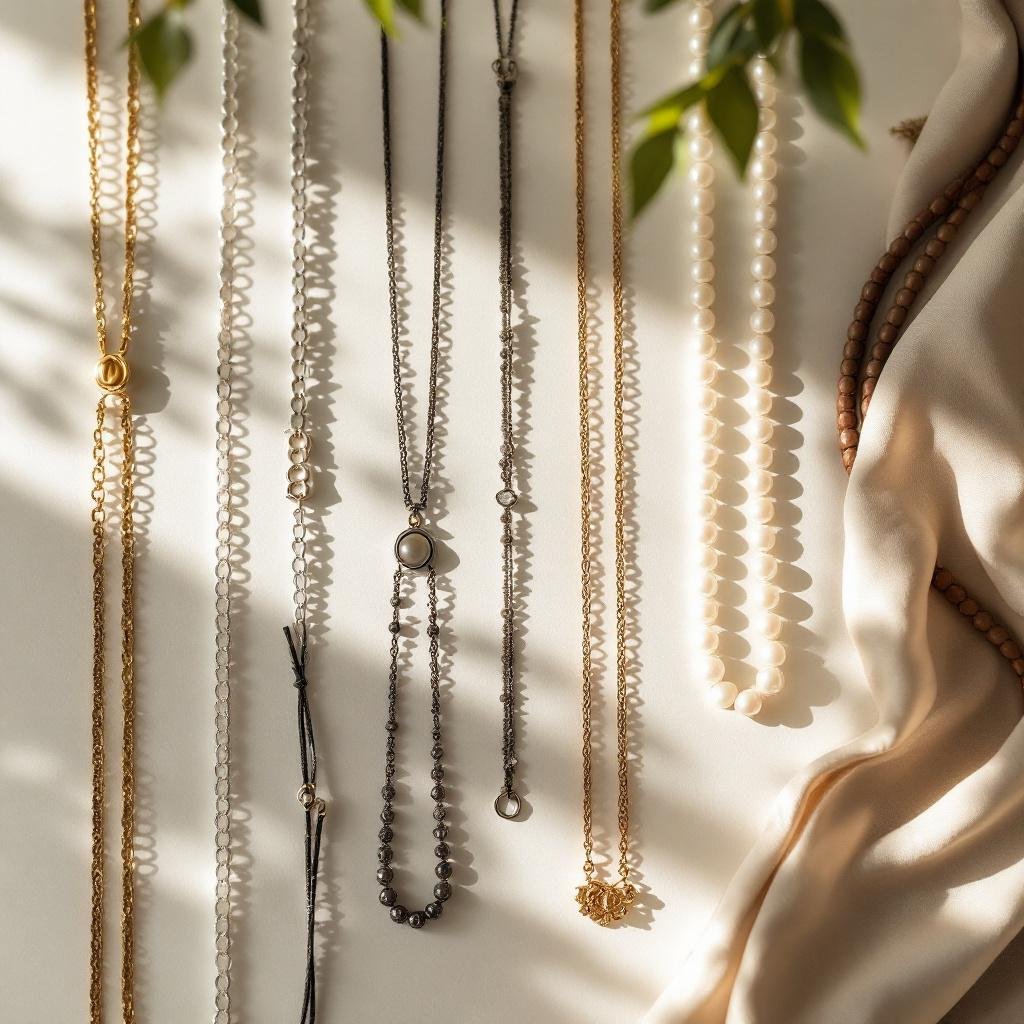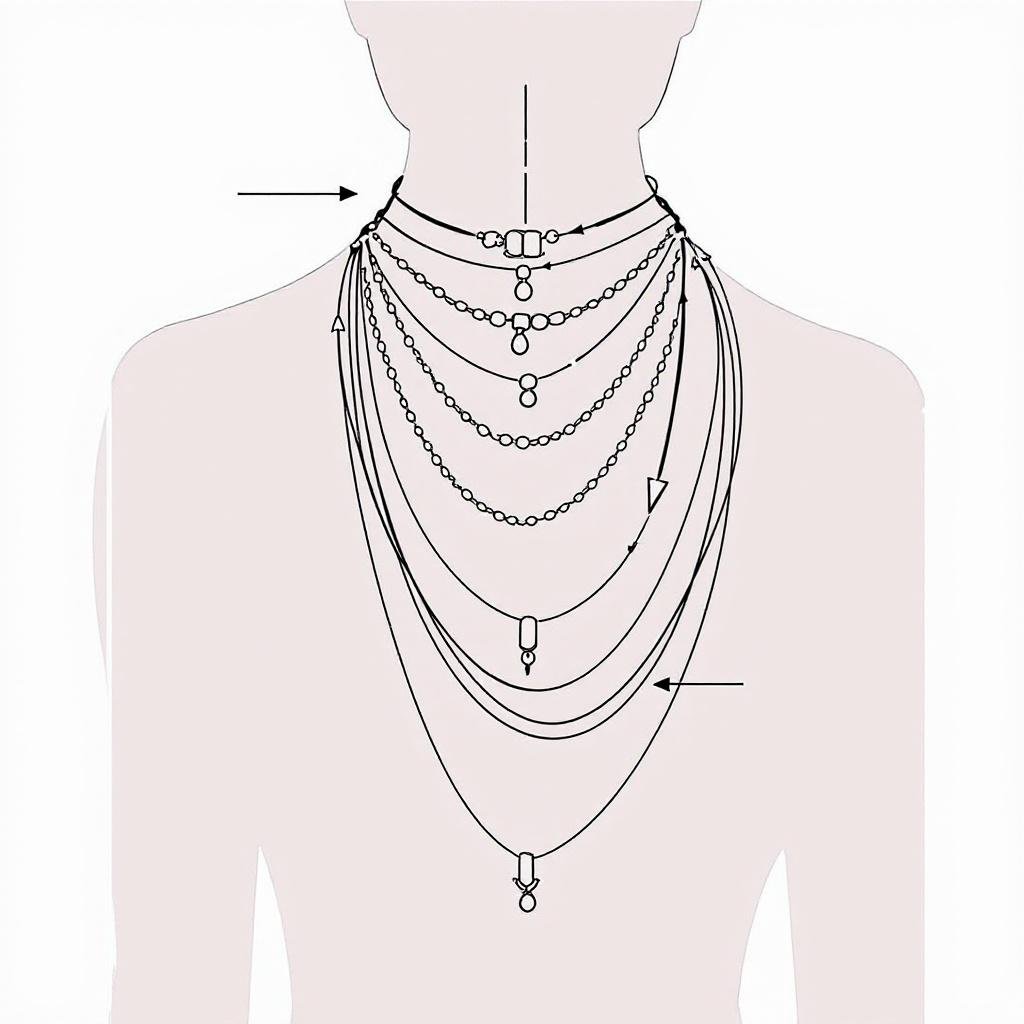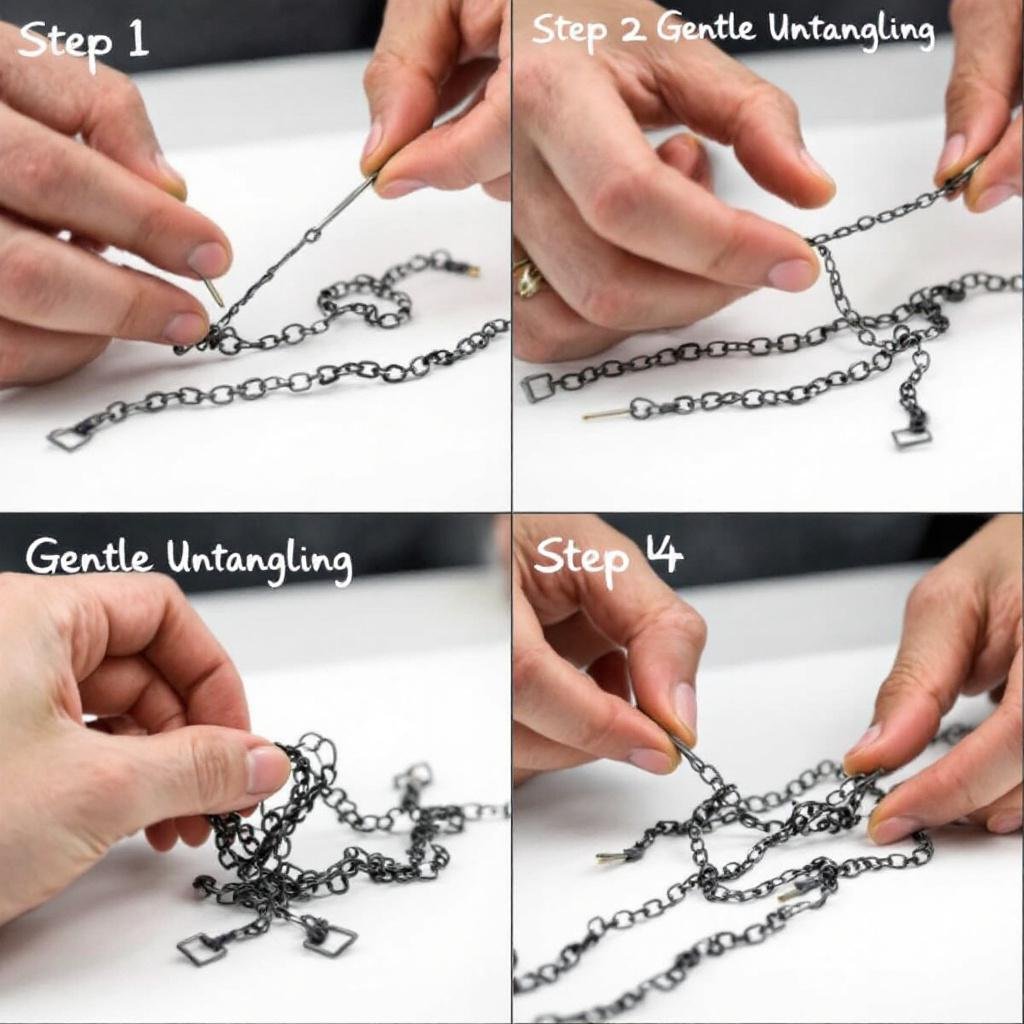After years of wrestling with twisted chains and spending countless minutes detangling my jewelry before important meetings, I finally discovered the secret that professional stylists use for how to layer necklaces without tangling. The breakthrough came during a particularly frustrating morning when I was running late and my three favorite necklaces had somehow formed what looked like a miniature sailor’s knot overnight. That moment of exasperation led me to research, experiment, and eventually master the techniques that have completely transformed my relationship with layered jewelry.

The Science Behind Why Necklaces Tangle
Understanding why necklaces tangle in the first place has been crucial to solving the problem permanently. When multiple chains of similar lengths and weights are worn together, they naturally want to occupy the same space around your neck. Delicate gold chains tend to squish and curl up into each other, sometimes creating pesky knots, especially when they’re made from similar materials and have comparable flexibility.
The physics of jewelry tangling involves several factors including chain flexibility, weight distribution, and movement patterns. Softer metals and thinner chains are more prone to tangling because they bend and twist more easily with body movement. Additionally, when necklaces are stored improperly or worn without consideration for their characteristics, they create the perfect conditions for chaos.
What changed everything for me was realizing that tangling isn’t just about bad luck or inferior jewelry quality, but rather about understanding the fundamental principles that govern how different chain types interact with each other. Once I grasped these concepts, preventing tangles became less about luck and more about strategic planning.

The Professional Stylist’s Foundation Rule
The most transformative technique I learned from professional stylists is what I call the “diversity principle.” Choose necklaces that are a diversity of lengths, thicknesses, chains, and materials rather than trying to match everything perfectly. This approach immediately reduces the likelihood of tangling while creating more visual interest and sophistication in your layered look.
When I started applying this principle consistently, my necklace drama virtually disappeared overnight. Instead of reaching for three similar delicate gold chains, I began combining a chunky statement piece with a medium-weight chain and a delicate strand. The different weights and textures naturally separate from each other, creating distinct layers that maintain their integrity throughout the day.
The key insight here is that contrast works better than coordination when it comes to preventing tangles. Heavy pieces anchor the look and stay in place, while varied textures prevent chains from sliding against each other and creating friction that leads to knotting. This principle has become so ingrained in my styling process that I now automatically consider weight and texture before considering aesthetic appeal.
Strategic Length Planning That Works
Length variation is perhaps the most critical aspect of successful necklace layering, and there’s a specific formula that professional stylists follow religiously. I’ve discovered that spacing your necklaces at least two inches apart creates enough separation to prevent tangling while maintaining the layered aesthetic. My go-to combination includes a choker at 14-16 inches, a princess length at 18 inches, and a matinee length at 22-24 inches.
However, the magic happens when you understand that these measurements should be adjusted based on your proportions and neckline choices. Someone with a longer neck can accommodate more layers, while those with shorter necks should focus on more dramatic length differences between pieces. I’ve learned to customize these standard measurements to work with my body and preferred clothing styles.
The strategic approach involves considering not just the total length of each necklace, but also how pendants and charms affect the visual weight and positioning. A long chain with a heavy pendant might hang similarly to a shorter chain without embellishment, so I always test combinations before committing to wearing them for extended periods.
The Weight Distribution Secret
Understanding weight distribution has been crucial to my success with layered necklaces. If the chains are of different thicknesses, the thicker ones will weigh down the thinner chains, which can cause tangling, but when done strategically, this weight difference can work in your favor to maintain proper positioning throughout the day.
I’ve found that placing the heaviest piece as the longest layer creates a natural anchor that helps keep everything in position. The weight pulls the chain down and away from the shorter layers, reducing the likelihood that they’ll cross over and tangle. Meanwhile, the lightest pieces work best as the shortest layers, where they can rest comfortably without being pulled out of place by heavier elements.
The revelation came when I realized that weight distribution isn’t just about preventing tangles, but also about creating a more comfortable wearing experience. When weights are properly distributed, no single area of your neck bears too much burden, and the jewelry feels balanced rather than awkward or heavy on one side.
Material Mixing for Maximum Compatibility
One of the most sophisticated techniques I’ve mastered involves strategic material mixing to prevent tangling while creating stunning visual combinations. Different materials have different friction coefficients, meaning some slide against each other smoothly while others tend to catch and twist together. Understanding these interactions has revolutionized my approach to layering.
Combining smooth materials like polished gold or silver with textured pieces like rope chains or beaded strands creates natural separation because the different surface textures don’t mesh together easily. Similarly, mixing metals with pearls or incorporating leather cords with traditional chains creates enough contrast to prevent the uniform tangling that occurs with similar materials.
I’ve discovered that the old rule about not mixing metals is completely outdated when it comes to layering for anti-tangle purposes. Mixing gold and silver pieces often works better than sticking to one metal because the different finishes slide past each other more easily than identical surfaces that want to bind together.

The Professional Storage System
Proper storage has proven to be just as important as wearing technique when it comes to maintaining tangle-free necklaces. Using a jewelry box with individual compartments or a necklace organizer with separate slots keeps each necklace separated and prevents them from getting tangled with one another, but the key is developing a system that you’ll follow consistently.
I’ve invested in a multi-level jewelry organizer where each necklace has its own designated space, but more importantly, I’ve trained myself to take the extra thirty seconds required to properly store each piece after wearing it. This small habit change has eliminated about ninety percent of the tangling issues I used to experience, simply because the necklaces never have the opportunity to interact with each other inappropriately.
For travel, I’ve developed a ritual of wrapping each necklace individually in soft tissue paper before placing them in separate compartments of my jewelry case. This prevents movement during transport and ensures that I arrive at my destination with perfectly organized jewelry ready to wear without any preliminary detangling sessions.
[ Amazon Suggestion: Multi-compartment jewelry organizer with individual necklace slots ]
The Game-Changing Accessories That Eliminate Problems
Professional stylists rely on specific accessories that most people don’t know exist, and these tools have completely changed my layering game. Multistrand necklace connectors allow you to link your chains to separate clasps, keeping each chain distant from the other, essentially creating a built-in organization system that you wear.
Necklace spacers have become my secret weapon for complex layering looks. These small devices, which cost just a few dollars, slide onto your chains and create physical barriers that prevent tangling while maintaining the natural drape of each piece. I keep several different sizes in my jewelry box and use them whenever I’m planning to wear more than two necklaces together.
Chain extenders have also proven invaluable for fine-tuning lengths without having to purchase new jewelry. When I find a combination that works perfectly but one piece is just slightly too short or too long, extenders allow me to achieve the ideal spacing that prevents tangling while maintaining visual harmony.

Texture Strategy for Advanced Layering
The most sophisticated approach to tangle-free layering involves understanding how different textures interact and using this knowledge strategically. Station necklaces with balls or beads don’t tangle with other chains because the three-dimensional elements create natural separators that prevent chains from sliding against each other and knotting.
I’ve built my layering collection around specific textural combinations that I know work well together. Smooth chains pair beautifully with rope or wheat chains because the different surface patterns prevent them from catching on each other. Similarly, incorporating one piece with geometric elements like squares or hexagons creates natural spacers that maintain separation.
The revelation about texture strategy came when I realized that visual interest and practical function could work together seamlessly. The most beautiful layered looks often incorporate enough textural variety to prevent tangling naturally, meaning that the most aesthetically pleasing combinations are also the most functional from a maintenance perspective.
Clasp Positioning and Weight Management
Understanding clasp positioning has been crucial to achieving comfortable, tangle-free layering that stays organized throughout the day. The weight and size of clasps can significantly affect how necklaces hang and interact with each other, and I’ve learned to consider these factors when planning layered looks.
Heavy or oversized clasps can pull necklaces backward and create uneven weight distribution that leads to tangling and discomfort. I’ve found that positioning heavier clasps on longer necklaces helps maintain balance while keeping lighter clasps on shorter pieces prevents them from being pulled out of position by weightier elements below.
The positioning strategy also involves considering how clasps will interact during movement. When all clasps are positioned at the same spot on the back of your neck, they tend to catch on each other and create points of friction that can lead to tangling. Slightly staggering the positions eliminates this issue and creates a more comfortable wearing experience.

Seasonal Considerations and Fabric Interactions
Different seasons and clothing choices require adjustments to layering techniques, and understanding these variables has helped me maintain tangle-free jewelry year-round. During winter months when I’m wearing high-neck sweaters and scarves, I focus on longer pieces that won’t get caught in fabric or create bulk under clothing layers.
Summer styling allows for more complex layering since there’s less fabric interference, but it also introduces new challenges like increased activity levels and exposure to swimming or sweating. I’ve learned to choose more durable materials and simpler combinations for active summer days, saving the complex layering for occasions when I’ll be more stationary.
The fabric interaction factor is particularly important when wearing textured clothing like knits or woven materials that can catch on delicate chains. I’ve developed different layering strategies for different types of clothing, ensuring that my jewelry enhances rather than conflicts with my outfit choices.
Professional Maintenance and Care Routines
Maintaining tangle-free necklaces requires consistent care routines that prevent problems before they start. I’ve established a daily ritual of gently cleaning each piece after wearing it to remove oils and debris that can cause chains to stick together. This simple step takes less than a minute but significantly reduces tangling issues.
Weekly deep cleaning involves more thorough attention to each piece, including checking for worn links or damaged areas that might be more prone to catching on other jewelry. I’ve learned to identify early warning signs that a necklace might be developing tangling issues, allowing me to address problems before they become frustrating emergencies.
The investment in proper jewelry cleaning supplies and storage solutions has paid for itself many times over in reduced frustration and eliminated the need for professional untangling services. Quality jewelry cloths, gentle cleaning solutions, and appropriate storage containers are essential tools for anyone serious about maintaining a collection of layer-able necklaces.
Troubleshooting Common Problems
Even with perfect technique, occasional tangling issues still arise, and I’ve developed reliable methods for addressing these situations without damaging delicate jewelry. The key is approaching tangles systematically rather than pulling randomly, which often makes problems worse and can damage chains permanently.
When I encounter a tangle, I start by laying the affected pieces on a flat surface and working with the loosest part of the knot first. Using two straight pins or needles, I gently separate the chains while applying minimal tension, working slowly and patiently rather than forcing movements that could create permanent damage.
Prevention remains far superior to correction, but having reliable untangling techniques reduces the stress associated with occasional problems. I’ve also learned to identify which combinations are more prone to tangling and adjust my wearing patterns accordingly, gradually eliminating problematic pairings from my regular rotation.

Building Your Tangle-Free Collection
Creating a collection of necklaces specifically chosen for layering compatibility has been one of my most worthwhile jewelry investments. Rather than randomly acquiring pieces and hoping they’ll work together, I now select necklaces based on how well they’ll integrate with my existing layering wardrobe.
My current collection includes foundational pieces in different lengths and weights that can be mixed and matched reliably, plus a selection of special occasion pieces that work with the basics for more elaborate looks. This systematic approach has eliminated the guesswork and reduced my collection to pieces that I wear regularly rather than items that look beautiful individually but don’t play well with others.
The building process involves testing new pieces with existing favorites before committing to expensive purchases. I’ve learned to evaluate not just how something looks, but how it behaves when layered with other pieces during normal daily activities. This practical approach has resulted in a smaller but more functional collection that serves my styling needs more effectively.
Advanced Styling Techniques for Special Occasions
For special events or photoshoots where I want more complex layering, I’ve developed advanced techniques that allow for elaborate combinations while maintaining tangle-free reliability. These approaches require more preparation time but create stunning results that wouldn’t be possible with standard layering methods.
The key to successful elaborate layering involves creating a base layer of compatible pieces and then adding accent elements strategically. I might start with two or three necklaces that I know work well together, then add a statement piece or decorative elements that enhance the look without disrupting the foundational stability.
For occasions where I’ll be photographed or need to maintain a perfect appearance for extended periods, I use temporary securing methods like small clips or pins hidden under the hair to ensure that each layer stays exactly in position. These techniques require practice but create professional-level results for important occasions.

The Psychology of Confident Jewelry Wearing
Mastering how to layer necklaces without tangling has had an unexpected psychological benefit: I now approach jewelry-wearing with confidence rather than anxiety. Knowing that my necklaces will stay organized throughout the day allows me to focus on other aspects of my appearance and daily activities rather than constantly worrying about jewelry maintenance.
This confidence has encouraged me to experiment with more adventurous combinations and express my style more boldly through layered jewelry. When you’re not worried about tangles and maintenance issues, you can focus on the creative and expressive aspects of jewelry styling, which has made getting dressed much more enjoyable.
The transformation from frustrated jewelry owner to confident layering enthusiast happened gradually as I mastered each technique, but the cumulative effect has been significant. I now look forward to selecting jewelry combinations rather than dreading potential problems, which has enhanced my overall relationship with personal styling.
FAQs
What's the most important rule for layering necklaces without tangling?
The diversity principle is crucial - combine necklaces of different lengths, weights, and textures rather than similar pieces. This prevents them from occupying the same space and tangling with each other.
How far apart should layered necklaces be spaced?
I recommend at least 2 inches between each layer. My standard spacing is 14-16 inches for chokers, 18 inches for princess length, and 22-24 inches for matinee length, adjusted for personal proportions.
Do necklace spacers work?
Absolutely! Necklace spacers have been game-changers in my layering routine. They create physical barriers that prevent chains from crossing over and tangling while maintaining a natural drape.
Can I layer necklaces of different metals?
Yes, and I recommend it! Different metals often slide past each other more easily than identical surfaces, reducing tangling. Plus, mixed metals create more visual interest.
Final Thoughts: Mastering the Art of Effortless Layering
Learning how to layer necklaces without tangling has transformed my daily routine from a source of frustration into one of creative expression and confidence. The techniques I’ve shared aren’t just theoretical concepts but practical solutions that I use every single day to create beautiful, functional jewelry combinations that stay organized from morning until night.
The most important insight I can share is that successful layering is about understanding the principles behind why tangles occur and then using strategic choices to prevent them. When you approach jewelry layering with knowledge rather than hope, you can create stunning combinations that enhance your style without creating maintenance headaches.
Remember that mastering these techniques takes practice, but the investment in learning proper layering methods pays dividends in reduced frustration, enhanced confidence, and expanded styling possibilities. Start with simple combinations and gradually work up to more complex looks as you develop your skills and understanding of how different pieces interact.


